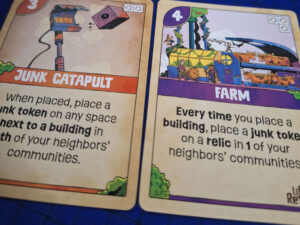 Best known for his mini-laden combat games, the versatile Eric Lang teamed up with Ken Gruhl, creator of Happy Salmon, to give us some lighter fare with Life in Reterra, a game with no monsters and nothing more villainous than a few pesky neighbors.
Best known for his mini-laden combat games, the versatile Eric Lang teamed up with Ken Gruhl, creator of Happy Salmon, to give us some lighter fare with Life in Reterra, a game with no monsters and nothing more villainous than a few pesky neighbors.
Set in a post-apocalyptic world, the lively game art by Hugo Cuellar suggests a comic, junk-strewn future. Your task is to rebuild civilization in this tile-laying game from Hasbro Gaming, designed for 2-4 players. It takes about 30 minutes to play.
Gameplay Overview:
To begin, you will choose five building types, placing their cards and a limited number of buildings for each type on the main board. There are several recommended starter sets, but you also may choose your own. The cards describe the building type, including end-game point values, and any special properties the building may have. The buildings themselves take up different amounts of space in your community.

You will design Reterra with land tiles representing varied terrain types, which may have relics or gears on them. You place buildings when you have created a layout with suitable terrain and gear icons matching a building shape.
When it’s your turn to lay a tile, you choose from a market of five random land tiles. You begin with a starter tile on your layout and three secret tiles in hand, any of which you may hold or play during your tile-laying phase.
Each player lays a tile and then replenishes the market, if necessary, before the next player’s turn. Adding a building is done at the moment you’ve created a valid space, which usually requires multiple tiles.
While you build Reterra into its final 4×4 grid, you will try to maximize contiguous terrain types, arrange gear icons to match the size and shape of the available buildings, and make use of any scoring boosts associated with buildings you’ve built.
When you place a land tile, you may use its gear icon, if present, to add an inhabitant instead of reserving the space for a building. In addition, once placed, buildings may allow you to add junk or cover relics with junk in other players’ communities. Some buildings may allow you to add relics or inhabitants to your own community.
Both inhabitants and relics in your community count for end game points.

Game Experience:
Cozy is how I’d describe Life in Reterra, which might be unusual for a re-building civilization game. There are echoes of Warsaw: City of Ruins in the tile placement and of Tiny Towns in the variability of the building sets. It’s a relaxing game to play. There’s a bit of a race to build desirable buildings but mostly the strategic choices are easy to make. Interestingly, although players’ strategies can vary a bit, the last 3 of 4 games I played had ties or one-point spreads at final scoring.

Life in Reterra’s strategic choices are limited vy the avilability of tiles and buildings. Everyone grabbed up energy source tiles whenver possible; they offered a lot of points. Some of the larger buildings also have powerful scoring potential.
As fast and simple as the gameplay is, you have to stay on top of everyone’s constructions; placed buildings may trigger powers or events that are easy to overlook and will cost you valuable points.
The variable building selections and options to choose friendly and “interactive” gameplay are welcome and help expand Life in Reterra’s time on the table.
Final Thoughts:
A light, quick to set up and quick to learn tile-laying game that is very pleasant to play. It is a fine filler game and will work well for family game nights.
 Final Score: 3.5 Stars – Fast playing, easy to learn, strategic tile-laying game great for family gaming.
Final Score: 3.5 Stars – Fast playing, easy to learn, strategic tile-laying game great for family gaming.
Hits:
• The art is fabulous and there’s a high-quality feel to the components.
• Quick games and variable building sets encourage repeated plays.
Misses:
• The art on the building tiles is a little too small to be effective.
• Randomly chosen building sets may not work well together.






















